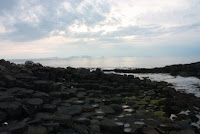
Thursday, March 19th
Kalfshamarsvik
On Thursday Signy, a friendly local on the board of the NES residency, took a few of us for a little trip to Kalfshamarsvik, about 20 km from Skagastrond, a place which used to be a fishing village at the beginning of the 20th century before declining. The place has a bit of a surreal feeling with basalt column formations all around.
The village
The village declined after the price of saltfish dropped due to a world depression; the Spanish Civil War of 1936 made things worse, since Iceland exported much of its fish to Spain. Icelanders searched for new ways of fish exports and this led eventually to the export of iced and frozen fish as well as the building of fish factories all over the country (like in nearby Skagastrond in 1938). This called for larger ships than before which in turn required better harbours. The small village of Kalfshamarsvik could not sustain fish industry on such a large scale and villagers moved away to larger communities.
A giant Giant's Causeway
Like the Giant's Causeway in Northern Ireland, Kalfshamarsvik has lots of basalt columns dipping into the sea but even bigger. Basalt is a volcanic rock type . Basal columns with polygonal and sometimes almost perfect hexagonal shapes are formed when the molten lava hits the surface. When the lava encounters either air or another cool rock, it cools down quite rapidly and by so doing starts shrinking. The shrinking process slowly develops into the depth, forming longer and longer columns.









No comments:
Post a Comment